The White cymbidium orchid can be found in nature in Northern Australia, as well as subtropical and tropical zones of Asia. Natural forms (more than 60 species) are distinguished by a wide variety of sizes, colors of flowers and leaves.
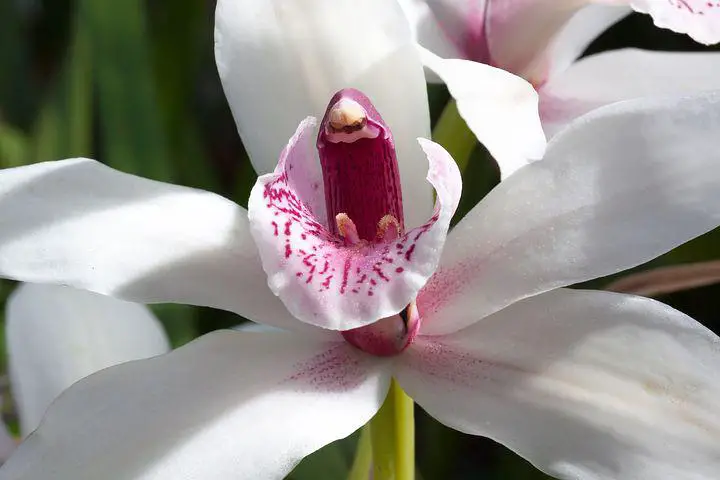
There are numerous hybrids, specimens of cymbidium orchid with small flowers are especially interesting – they smell the strongest.
White Cymbidium Orchid Varieties and names with photos
White Cymbidium grows in height from 20 cm to 1 m. Pseudobulbs are oval in shape and are located close to each other, their height, depending on the variety, is from 1 to 15 cm. (Check out Cymbidium Pseudobulbs Varieties)
The leaves are narrow, leathery, and elongated, with pointed tips. Peduncles can be a different numbers. Cymbidium flowers are divided into straight and hanging (ampelous).
One peduncle in cymbidium is rare and occurs only in large-flowered varieties.
The petals have a variety of colors – numerous shades of cream, yellow-green, yellow, pink, red, brown. The lip is colored, as a rule, more brightly and often non-uniformly. Large-flowered varieties of cymbidium orchids are among the most popular cut flowers.
Ice Cascade Cymbidium
It grows naturally in Australia and Southeast Asia. It is an ampelous variety of cymbidium. Flowers white, small. In racemes up to 300 flowers.
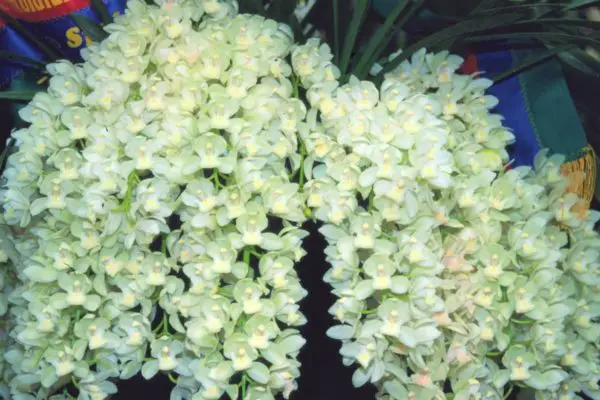
They bloom gradually, thus, the flowering period stretches for many months. This feature, as well as the unpretentiousness of the plant, make it very popular with flower growers for home cultivation. The smell is pleasant.
Ivory Cymbidium (Eburneum)
Known as ebunerum or ivory. The flowers are large, cream in buds, after blooming – white. The petals are wide, in the middle of the upper one there is a light creamy-pink stripe.
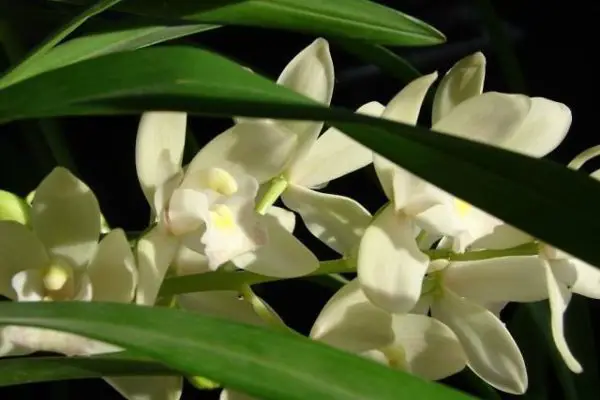
The “beard” on the lip is bright yellow. The aroma is pleasant and unobtrusive, a bit like lilac. Blooms mainly in spring. In cultivation, white cymbidium is unpretentious.
Daya cymbidium orchid
Widespread species in nature. The leaves are narrow, thin, pointed, on one pseudobulb there can be from 4 to 12 leaves arranged in two rows. Hanging peduncle grows up to 30 cm.
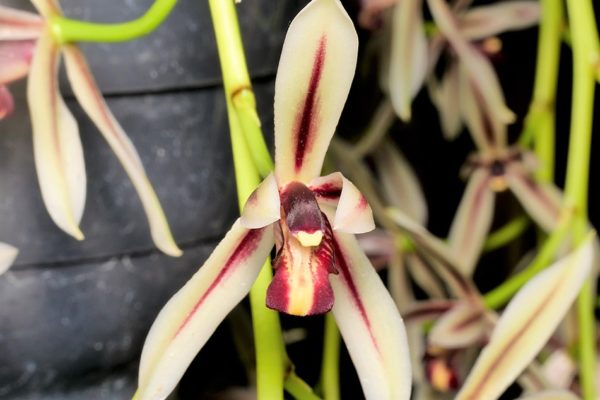
The petals are narrow, widely spaced, can be directed forward, have a color from white to cream with longitudinal chestnut or purple stripes in the center. The lip is the same color with stripes, white patches and a yellow stripe. The aroma is pleasant and strong. Flowering begins in August and lasts until December.
Cymbidium insigne
Homeland China, Vietnam, Thailand. On each stem, from 9 to 15 brushes are formed. The flowers are not large, the diameter is not more than 8 cm. The petals are light or bright pink in color with red spots. Flowering begins in February and lasts until May.
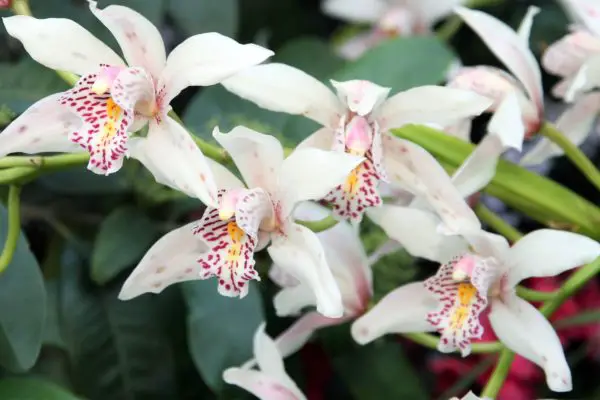
You may also like Yellow Cymbidium Orchid.
white cymbidium orchid Care at Home
Cymbidium needs plenty of light, but cannot tolerate direct sunlight and high temperatures. It is recommended to choose a place for it that provides a difference between night and day temperatures of three to four degrees. In general, the optimal temperature for this orchid during the growing season is + 18-25 ° C, and during the dormant period it is necessary to reduce it to + 13 ° C.
Watering Cymbidium prefers plentiful throughout the year, to increase humidity it is recommended to spray it once or twice a week. The exception is the dormant period, when watering is reduced to a minimum.
This genus of orchids needs regular feeding, preferably two to three times a month.
white cymbidium orchid Diseases and pests
Various types of rot: black, brown, root, gray, fusarium. Anthracnose, rust, leaf spot. Viral diseases: cymbidium mosaic, ring virus, cattleya mosaic. As well as herbivorous mites (spider mites, flatworms, bulbous), aphids, thrips.
white cymbidium orchid reproduction
You can propagate white cymbidium orchid by dividing the rhizome by two to four pseudobulbs in each new instance.
First steps after purchase
When buying Cymbidium, it is recommended to conduct a thorough inspection of the plant. The absence of visible signs of diseases and pests does not always indicate exceptional health. A new plant needs mandatory quarantine. Transplantation is allowed only in the absence of a peduncle.
Pots for White Cymbidium Growth
Cymbidium is grown in small pots in special soil. Repotting is recommended once every three years. When propagating, a part of young shoots is separated with three or four pseudobulbs, half of which are old, brown.
The watering rule that applies to all orchids fully applies to Cymbidium: it is better to underfill than overfill.
Possible Problems you face during caring for white cymbidium orchid
- Brown spots on leaves
- Cause: Sunburn.
- Soft brown spots on leaves
- fungus.
- Gray rot (mold) on the leaves
- Reasons: spraying at low air temperature.